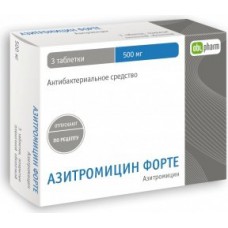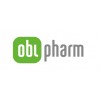Expiration date: 04/2026
Tablets, film-coated 1 tab.
azithromycin (in the form of dihydrate) 250 mg
Pharmacological action
Antibiotic macrolides, is representative of azalidov. Inhibits RNA-dependent protein synthesis of sensitive microorganisms.
Active against gram-positive bacteria: Staphylococcus aureus, Streptococcus spp. (including Streptococcus pneumoniae, Streptococcus pyogenes /group A/), gram-negative bacteria: Haemophilus influenzae, Haemophilus parainfluenzae, Haemophilus ducreyi, Moraxella catarrhalis, Escherichia coli, Bordetella pertussis, Bordetella parapertussis, Borrelia burgdorferi, Neisseria gonorrhoeae, Campylobacter spp., Legionella pneumophila, anaerobic bacteria: Bacteroides fragilis.
Azithromycin is also active against Chlamydia trachomatis, Mycoplasma pneumoniae, Mycoplasma hominis, Treponema pallidum.
It is also active against Toxoplasma gondii.
Pharmacokinetics
Rapidly absorbed from the gastrointestinal tract. Eating reduces the absorption of azithromycin. Cmax in plasma achieved through 2-3 h. Rapidly distributed in tissues and biological fluids. 35% of azithromycin is metabolized in the liver by demethylation. More than 59% is excreted with bile in an unmodified form, about 4.5% - with urine in an unmodified form.
Indications
Infectious-inflammatory diseases caused by susceptible to azithromycin microorganisms, including bronchitis, pneumonia, infections of skin and soft tissue, otitis media, sinusitis, pharyngitis, tonsillitis, gonorrheal and degeneracy urethritis and/or cervicitis, Lyme disease (borreliosis).
Dosage regimen
Establish individually taking into account nosological form, severity of a course of a disease and sensitivity of the exciter.
Adults inside-0.25-1 g 1 time/, children-5-10 mg/ kg 1 time / duration 2-5 days.
Side effect
From the digestive system: nausea, vomiting, flatulence, diarrhea, abdominal pain, transient increase in liver enzymes, rarely - cholestatic jaundice.
Allergic reactions: rarely - skin rash, angioedema, erythema multiforme, Stevens-Johnson syndrome, toxic epidermal necrolysis.
Dermatological reactions: rarely-photosensitization.
From the Central nervous system: dizziness, headache, rarely - drowsiness, weakness.
From the hematopoietic system: rarely-leukopenia, neutropenia, thrombocytopenia.
Of the cardiovascular system: rarely-pain in the chest.
From the genitourinary system: vaginitis, rarely-candidiasis, nephritis, increased residual urea nitrogen.
Other: rarely-hyperglycemia, arthralgia.
Contraindications
Hypersensitivity to azithromycin and other antibiotics of the macrolide group.
Application during pregnancy and breast-feeding
Azithromycin penetrates through the placental barrier. Application of pregnancy is possible only in cases, when the intended benefits to the mother outweighs the potential risk to the fetus.
If necessary, the use of azithromycin during lactation should resolve the issue of termination of breastfeeding.
Application for violations of liver function
It is not recommended to use in patients with impaired liver function.
Application for violations of renal function
Use with caution when impaired renal function.
Special instruction
It is not recommended to use in patients with impaired liver function.
Use with caution when impaired renal function.
Azithromycin should be taken at least 1 hour before or 2 hours after meals or antacids.
Drug interaction
While the use of ergot alkaloids it is impossible to exclude the risk of ergotism.
With simultaneous use of azithromycin with warfarin, cases of amplification of the latter effects are described.
With simultaneous use of digoxin or digitoxin with azithromycin may significantly increase the concentration of cardiac glycosides in blood plasma and the risk of glycoside intoxication.
At simultaneous application with dizopiramidom described the case of ventricular fibrillation.
At simultaneous application with lovastatin cases of development of rhabdomyolysis are written.
While the use of rifabutin increases the risk of neutropenia and leukopenia.
With simultaneous use, the metabolism of cyclosporine is disturbed, which increases the risk of adverse and toxic reactions caused by cyclosporine.


